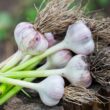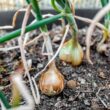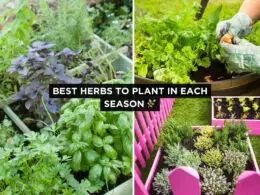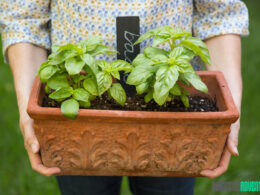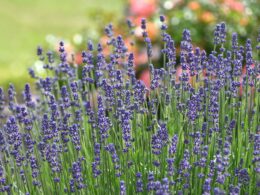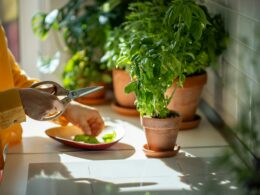In This Article Show
Basil is one of the most popular herbs every gardener other creates a garden for or uses as a companion plant for other herbs, vegetables, and flowers.
However, when the basil plant starts to flower, many know if those flowers need to go or stay. Those purple or white flowers Basil produces during summer when it has not been pruned need to go, and luckily there are easy ways that can be taken care of.
The flowers from the basil plant can be a sign that your plant is shutting down. Basil is one of those herbs that are pretty easy to grow; however, just like every other plant, it is essential to learn their requirements to care for them. Basil plant will thrive in many conditions; it likes to stay moist and requires approximately 1 inch of water weekly.
Why the basil plant grows flowers: Basil plants will flower if left unpruned; however, they can also start to bloom when it has completed their life cycle. Other things that can lead to your basil flowering include stress which is known as bolting, high summer temperature, and water stress.
There are different varieties of basil; basically, they all require the same care and similar requirements. Before you start worrying about the causes of your basil herb flowering, know it’s not anything you did. Read on to learn why basil is flowering and what you can do about it.

Understanding Growing And Caring For Basil
To grow basil, there are a couple of things that you have to keep in mind.
Get Gardening For Beginners
Our new EBOOK shows newcomers and green thumbs alike a step by step guide to growing the garden of their dreams.
This herb is a member of the mint family that can be grown without any fuss hence why it is considered the most popular type of herb to be grown both in containers and in the ground. Basil leaves are popular Thai ingredients, and since it’s an annual, they tend to proliferate.
We do agree that basil leaves are not that complicated to grow; however, if proper care is not taken, they can stop to produce leaves. The easiest way to grow basil is from seed, and to ensure it germinates and it’s ready to be harvested in no time, here is a step-by-step guide to taking care of basil.
- Choose a location with plenty of sunlight for basil leaves.
- Water consistently and regularly, basil likes to stay moist, so it requires approximately 1 inch of water every week. It would be best if you water early in the morning for the best result.
- Basil is a vigorous grower, so it requires little to no fertilizer.
- As soon as the basis;l plant has two sets of true leaves, pinch from the tip of the basil leaves; this encourages further growth.
- Companion plant your basil with crops of mutual benefits. This old garden strategy can help deter pests, improve the taste of your basil leaves, and yield growth.
- Keep a close eye on your basil leave; basil tends to bold once the summer sun is too harsh, so you can prevent this by keeping it moist and providing shade.
Here are tips on how to harvest basil leaves properly and encourage them to keep growing.
- Harvest basil regularly, and to encourage new growth, aim to remove 1/3 of the leaves each month.
- Snip the stems where the two large leaves meet.
Why Is My Basil Flowering?
If you have enjoyed growing and plucking your basil leaves for a while, it can be quite surprising to discover it flowering after a while.
So, if your basil has flowered, then you should remove it. There are three stages in the life cycle of basil, the first is the juvenile stage, where it is still growing, the second is the transition stage, where it won’t be producing as much and then there is the production stage, where flowers start to bloom, and leaves stop growing.
You should know that pinching out the flowers before they bloom fully will encourage them to stop blooming and rather concentrate on producing leaves, which also extends the life cycle. If you do not mind the flowers, then you can let it be; however, if you are cultivating basil strictly for the leaves, you should remove the flowers.
Basil flowers can be white or purple, depending on your growing variety. This happens when your basil has been left unpruned, but other factors that can cause basil plants to flower are water stress, bolting, and high summer temperature.
Get Gardening For Beginners
Our new EBOOK shows newcomers and green thumbs alike a step by step guide to growing the garden of their dreams.
To prevent flowers from developing, you simply have to prune regularly, and if it has flowered already, you should snip them off, put them in a bud vase, and place them on your window sill as they are really pretty.
The basil flowers are also edible; you can sprinkle them on your salad but note that you might get bitter-tasting basil leaves.

How to Stop Basil From Flowering And What to do When it Does
We have stated earlier that there are stages to the basil’s life cycle, and it tends to produce flowers in the third stage; however, it’s not the only thing that can cause the basil to start flowering. Other reasons it can start to flower include water stress, high summer temperature, and transplanting stress.
As soon as you notice your basil has started to flower or there are signs it’s about to bloom, and you want rather to keep harvesting the leaves, we have listed ways you can stop it from flowering.
- You can prevent the basil from flowering by regularly harvesting the leaves. Pinch the leaves regularly for your culinary use.
- If it has started to flower, pinch off the flowers; this should force the growth of new leaves. It is also recommended to half the plant, and you can make pesto.
- Prune your plant every 2 to 3 weeks; that should stop it from flowering.
- In conclusion, pruning your basil regularly is the key to preventing and getting rid of flowers on basil. Pruning ensures your basil does not exceed 8 inches.
Frequently Asked Questions
Does basil come back after flowering?
Yes, basil will surely start to grow leaves back after you have to snip the flowering. Basil is a cut and comes again plant, so you can always harvest it again and again if it does flower, pinch off the flowers or harvest half the plant, and it will grow back in a week or two.
Is it okay to eat basil after it flowers?
The basil flower is edible so even after its flowers; all parts are still edible. However, the leaves might be a bit bitter or have a milder taste after it starts to flower. Regardless basil leaves are still okay to eat after they flower.
Why is my basil plant flowering?
If basil starts to flower, it only follows its natural growth cycle, part of its natural growth cycle, and seeds will follow it. These seeds can be used to grow new basil or pinch the flowers back to encourage them to grow leaves again.
How do you pick basil, so it keeps growing?
To encourage the basil to keep growing after picking it, you should pinch the central stem back, and be 1/4 inch above the leaf axis. This process forces the plant to branch and keeps growing.
Wrapping Up
Even after basil flowers, it is still wholly okay to eat, but the taste is mild, and you might notice some bitter taste depending on the variety. Hence, we recommend keeping your eye on your basil, and if there is any sign of whitish-purplish flowers, your basil is shutting down, and you have to pinch the flowers immediately.
Basil plants are hardy plants, so they need very little maintenance. They will survive with well-drained soil, occasional watering, sunlight, and good air circulation.
Most people grow basil in containers and place them where they can get enough sunlight, and they do just fine.

